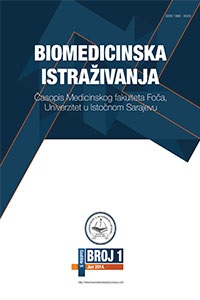Need for orthodontic treatment among children in Foča
DOI:
https://doi.org/10.7251/BII1701057IAbstract
Introduction. Orthodontic treatment is a common dental procedure in developed
countries. Assessment of orthodontic treatment need is important
for health services planning and population trends monitoring. The aim of
this study was to assess the need for orthodontic treatment among children
in Foča, Bosnia and Herzegovina.
Methods. The study involved 81 students of two primary schools in the
municipality of Foča, aged 11-13 years. The subjects underwent clinical
examinations, the dental impressions were taken, study models were made
and analyzed, and digital photographs of anterior dentition were taken too.
Index of Complexity, Outcome and Need (ICON) was used to assess the
need for orthodontic treatment. The number of orthodontists, which would
be sufficient to meet the needs of this population of children, was estimated.
Results. ICON index results showed that 56.8% of children needed orthodontic
treatment. There was no statistical significance in the need for orthodontic
treatment between the subjects of different gender and age. The study showed
that 22.2% of boys and 34.6% of girls needed orthodontic treatment. In relation
to age, 21% of eleven- and 21% of twelve-year-olds needed orthodontic
treatment and 14.8% of thirteen-year-olds. The incidence of crowding was
80.2%. Crossbite was present in 23.5% of examined students, open bite in 2.5%,
deep bite in 29.6% and irregular dental esthetics anterior teeth in 28.4%. Class
II/1 malocclusion was found in 39.5% of children, II/2 class in 9.9%, class I in
38.3%, while class III malocclusion was found in 9.9% of examined children.
Conclusion. The study shows that a large percentage of children in Foča need
orthodontic treatment. Percentage of the need for orthodontic treatment is
higher in comparison to most of the countries in Europe and the world. The
development of prevention programs and early caries therapy can greatly
reduce the need for orthodontic treatment.

